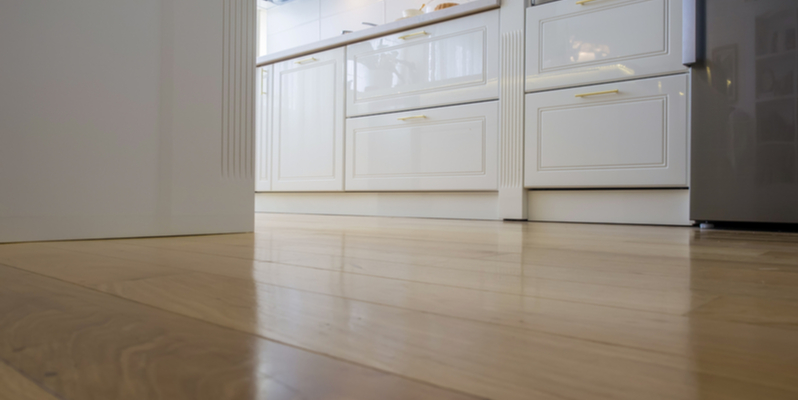Whether you are remodeling your kitchen in your existing home or planning a new kitchen in your new build, choosing the ideal kitchen floor is an important decision. Within that decision, you need to consider several factors – such as your floorplan, as well as how much you cook, and which flooring would be the most durable for you and your family’s lifestyle. Here are some of the most popular flooring choices available today and tips to help you chose the one perfect for your new kitchen.
Hardwood Floors
Hardwood flooring is a timeless choice that will always be in style. It is a great choice because it is durable and looks great unifying your spaces as it extends throughout the home designed with an open floor plan. Hardwood flooring gives your space beautiful aesthetics as well as warmth that is unmatched by other flooring options. In addition, because hardwood flooring never goes out of style, it provides an excellent return on investment if you choose to sell your home.
Hardwood flooring offers low maintenance is long lasting able to weather decades of use. Should you choose prefinished hardwood, you will also gain moisture-resistant flooring adding to its longevity and ideal for the kitchen. Hardwood flooring is available as engineered wood planks or solid wood strips. For kitchens, engineered wood planks are the best option between the two as it is less vulnerable to the temperature and humidity changes of household kitchens.
Porcelain Tile Floors
Porcelain tile (a type of ceramic tile) flooring wins the competition for durability. As tile fired at length at high temperatures it is hard, tough, stain and moisture resistant making it low maintenance as well. It is so durable you can even use it outdoor in almost every climate. Porcelain tiles comes in glazed and unglazed varieties. Glazed porcelain tiles feature a glass-like coating which can be fashioned in any color, providing the look as well as the texture of natural stone at considerable cost savings. Unglazed porcelain tiles assume the natural color of the original clay, and offer homeowners organic earth tones from which to choose. When choosing porcelain tiles, select those certified as slip-resistant, thus adding an extra measure of safety in the kitchen
Vinyl Floors
Vinyl flooring (this is not linoleum) is a budget friendly, easy to maintain option for those who cook frequently. Known as resilient flooring, vinyl is the softest option, offering up a cushion-like feel known to reduce muscle fatigue. As such it also means less breakage should you or a member of your family drop breakable plates, glasses, etc. Vinyl flooring, also known as sheet vinyl, is easy to clean being both stain-proof and water-proof. The only maintenance vinyl requires is sweeping and mopping.
Vinyl flooring comes in a variety of patterns and colors. The thicker versions offer textured surfaces as well and can even look like ceramic tile or natural stone. Textured vinyl flooring is a great choice in the kitchen where it provides traction should your floor get wet. Vinyl flooring also resistant to scratches and scuffing thanks to the addition of a “wear layer.” The layer eventually wears thin, but most vinyl brands guarantee the “wear layer” for 10 to 15 years.
The single drawback comes if you have a large kitchen. Vinyl flooring comes in a standard width of 12 feet, which means wider kitchens will have seams. These seams can allow moisture and dirt into the subfloor unless they are bonded properly. Bonding tightly is made more difficult due to the cushioning quality of the vinyl.

